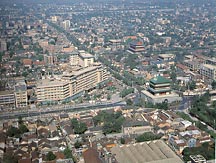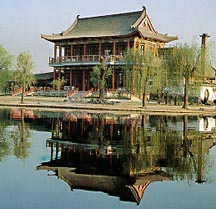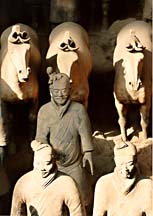 Xi’an was one of the most important cradles of Chinese civilization. It marked the start of the famous “Silk Road” that linked China with central Asia and the Roman Empire. And it served as the first capital of a unified China and capital of 11 dynasties periodically from the 11th century B.C. to the early 10th century A.D. Xi’an, or Chang’an as it was called in ancient times, is known as the city of “Everlasting Peace.” Located between rivers and mountains in the center of the fertile Guanzhong Plain in Shaanxi Province, Xi’an–the provincial capital–was a natural place to nurture the nation’s civilization.
Xi’an was one of the most important cradles of Chinese civilization. It marked the start of the famous “Silk Road” that linked China with central Asia and the Roman Empire. And it served as the first capital of a unified China and capital of 11 dynasties periodically from the 11th century B.C. to the early 10th century A.D. Xi’an, or Chang’an as it was called in ancient times, is known as the city of “Everlasting Peace.” Located between rivers and mountains in the center of the fertile Guanzhong Plain in Shaanxi Province, Xi’an–the provincial capital–was a natural place to nurture the nation’s civilization.
In the Neolithic Age, about 6,000 years ago, excavations show a matriarchal clan was formed at Banpo village in the region. Thousands of years later, the Zhou Dynasty kings established their capital in settlements only a few miles from the present-day city. In 231 B.C., Qin Shi Huang, the first emperor of unified China, set about enlarging the settlement of Xiangyang, about 15 miles northwest of the city. This town, established under earlier Qin rulers as the capital, became heavily populated, so that in 213 B.C., Qin Shi Huang decided to move his court to the south bank of the Wei River. A vast palace was begun, however, work was never completed in his lifetime. Some years later when the Qin fell to the Han (206 B.C.), this and most of the other palaces were destroyed. The conqueror, Liu Bang, first emperor of the Han Dynasty, also established the site of his capital only a few miles north of modern Xi’an.
 From about 35 A.D., the town went into a decline that lasted about five and a half centuries, until, in 583 A.D., the Sui emperor, Wen Di, established his capital southeast of Chang’an. The city flourished and developed so quickly under the Tang Dynasty that in time it became the most important city in Asia, with a population of more than a million people living in a vast, well-planned area protected by large walls with ramparts. The area occupied by the old city was greater than that of present-day Xi’an. For over a millennium, from the Second Century B.C., China’s silk was transported from Xi’an to central Asia and Europe. Although damaged by several wars, Xi’an, covering 880 square miles and with a population of 3,915,000 (6,000,000 in the urban area) still contains a host of historical sites.
From about 35 A.D., the town went into a decline that lasted about five and a half centuries, until, in 583 A.D., the Sui emperor, Wen Di, established his capital southeast of Chang’an. The city flourished and developed so quickly under the Tang Dynasty that in time it became the most important city in Asia, with a population of more than a million people living in a vast, well-planned area protected by large walls with ramparts. The area occupied by the old city was greater than that of present-day Xi’an. For over a millennium, from the Second Century B.C., China’s silk was transported from Xi’an to central Asia and Europe. Although damaged by several wars, Xi’an, covering 880 square miles and with a population of 3,915,000 (6,000,000 in the urban area) still contains a host of historical sites.
FOREST OF STELE:
The Forest of Stele, which is located on the site of the ancestral temple of the Tang Dynasty. The Forest of Stele was first founded in 1090 A.D. during the Song Dynasty. It is the oldest and richest collection of steles in China. The stele are numerous enough to be likened to a forest, hence the name. This museum consists of six large exhibition halls, seven corridors and a stele pavilion. There are more than 1,000 stele of eight dynasties from the Han down to the Qing. They are of great value to historians and for the study of calligraphic development.
MAUSOLEUM OF QIN SHI HUANG AND MUSEUM OF THE QIN TERRACOTTA FIGURES:
 Qin Shi Huang was the founding emperor of the Qin Dynasty. His tomb is on the south bank of the Wei River, about three miles east of the country town of Lintong. It is one of China’s most important historical sites, and has been named a World Heritage Site by UNESCO. Begun in 247 B.C., when Qin Shi Huang was enthroned at the age of 13, the mausoleum is in fact a deep and magnificent underground palace. According to records, more than 700,000 people were employed to construct it, and the work took 36 years to complete. In 1974 and 1976, three massive army vaults were discovered. In Vault No. 1, the largest, 6,000 life-size terra-cotta figures of armed warriors and horses were buried. An underground feat of civil engineering, Vault No. 1 is 351 yards long from east to west, 68 yards wide from north to south, and 5.47 yards deep, covering an area of 15,601 sq. yd. The three army vaults were ascertained by archaeologists to be pits for burial objects accompanying the tomb of Qin Shi Huang. In October 1979, an on-site museum was built above Vault No.1. Since then, two additional structures have been built to cover vaults two and three Ranging from 5.8 to 6 ft. in height, the vivid life-size warrior figures are clad in armor or short gowns belted at the waist, with leggings and tightly-lashed boots, and holding real weapons—bows and arrows, swords and spears.
Qin Shi Huang was the founding emperor of the Qin Dynasty. His tomb is on the south bank of the Wei River, about three miles east of the country town of Lintong. It is one of China’s most important historical sites, and has been named a World Heritage Site by UNESCO. Begun in 247 B.C., when Qin Shi Huang was enthroned at the age of 13, the mausoleum is in fact a deep and magnificent underground palace. According to records, more than 700,000 people were employed to construct it, and the work took 36 years to complete. In 1974 and 1976, three massive army vaults were discovered. In Vault No. 1, the largest, 6,000 life-size terra-cotta figures of armed warriors and horses were buried. An underground feat of civil engineering, Vault No. 1 is 351 yards long from east to west, 68 yards wide from north to south, and 5.47 yards deep, covering an area of 15,601 sq. yd. The three army vaults were ascertained by archaeologists to be pits for burial objects accompanying the tomb of Qin Shi Huang. In October 1979, an on-site museum was built above Vault No.1. Since then, two additional structures have been built to cover vaults two and three Ranging from 5.8 to 6 ft. in height, the vivid life-size warrior figures are clad in armor or short gowns belted at the waist, with leggings and tightly-lashed boots, and holding real weapons—bows and arrows, swords and spears.
BIG GOOSE PAGODA:
Located a couple of miles south of Xi’an, the Big Goose Pagoda, the city’s emblem, was first built in 653 A.D. as part of the Ci’em. Xuan Zang, a renowned monk returned from a pilgrimage to India and neighboring countries, proposed that the pagoda be built to store Buddhist scriptures he had brought back. Xuan Zang was made abbot of the temple, where be translated the scriptures into Chinese. From 701 to 704, the five-story pagoda was rebuilt into a seven-story, 331 ft. high structure with stairs winding to the top floor. Built with gray bricks, this pavilion-like pagoda with arched portals on each floor is a masterpiece of Buddhist architecture with a distinct Chinese style.
SMALL GOOSE PAGODA:
This temple is near the Big Goose Pagoda, and was built in 707 AD It has 15 stories and is 148 ft. high. It has a fine and delicate style. On the north and south doors are exquisitely-carved ivory designs and Buddhist figures.
BANPO MUSEUM:
This Neolithic site is a few miles from Xi’an. The Banpo people settled here some 6,000 years ago. They cultivated their land, built horses, and lived as primitive clan. Five excavations since 1954 have uncovered a village of 45 houses, stone-age pottery, tools, and bones. The site covers an area of 60,000-square yards. It is divided into living quarters, a pottery-making center and a graveyard. The museum built to protect the site covers some 33,400 square feet.